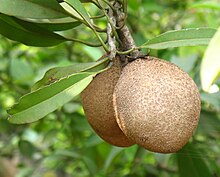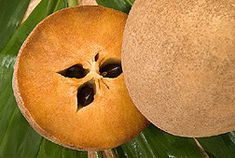Manilkara zapota
| Sapodilla | |
|---|---|
 |
|
| Scientific classification | |
| Kingdom: | Plantae |
| (unranked): | Angiosperms |
| (unranked): | Eudicots |
| (unranked): | Asterids |
| Order: | Ericales |
| Family: | Sapotaceae |
| Genus: | Manilkara |
| Species: | M. zapota |
| Binomial name | |
|
Manilkara zapota (L.) P.Royen |
|
| Synonyms | |

Fruit, cross-section
|
|
| Nutritional value per 100 g (3.5 oz) | |
|---|---|
| Energy | 347 kJ (83 kcal) |
|
19.96 g
|
|
| Dietary fiber | 5.3 g |
|
1.1 g
|
|
|
0.44 g
|
|
| Vitamins | |
| Riboflavin (B2) |
(2%)
0.02 mg |
| Niacin (B3) |
(1%)
0.2 mg |
| Pantothenic acid (B5) |
(5%)
0.252 mg |
| Vitamin B6 |
(3%)
0.037 mg |
| Folate (B9) |
(4%)
14 μg |
| Vitamin C |
(18%)
14.7 mg |
| Minerals | |
| Calcium |
(2%)
21 mg |
| Iron |
(6%)
0.8 mg |
| Magnesium |
(3%)
12 mg |
| Phosphorus |
(2%)
12 mg |
| Potassium |
(4%)
193 mg |
| Sodium |
(1%)
12 mg |
| Zinc |
(1%)
0.1 mg |
|
|
|
|
|
| Percentages are roughly approximated using US recommendations for adults. Source: USDA Nutrient Database |
|
Manilkara zapota, commonly known as the sapodilla (/ˌsæpəˈdɪlə/), is a long-lived, evergreen tree native to southern Mexico, Central America and the Caribbean. An example natural occurrence is in coastal Yucatán in the Petenes mangroves ecoregion, where it is a subdominant plant species. It was introduced to the Philippines during Spanish colonization. It is grown in large quantities in Pakistan, India, Thailand, Malaysia, Cambodia, Indonesia, Bangladesh and Mexico.
The name "zapota" from the Spanish zapote [θaˈpote] ultimately derives from the Nahuatl word tzapotl.
Sapodilla can grow to more than 30 m (98 ft) tall with an average trunk diameter of 1.5 m (4.9 ft). The average height of cultivated specimens, however, is usually between 9 and 15 m (30 and 49 ft) with a trunk diameter not exceeding 50 cm (20 in). It is wind-resistant and the bark is rich in a white, gummy latex called chicle. The ornamental leaves are medium green and glossy. They are alternate, elliptic to ovate, 7–15 cm (2.8–5.9 in) long, with an entire margin. The white flowers are inconspicuous and bell-like, with a six-lobed corolla. An unripe fruit has a firm outer skin and when picked, releases white chicle from its stem. A fully ripened fruit has saggy skin and does not release chicle when picked.
...
Wikipedia
